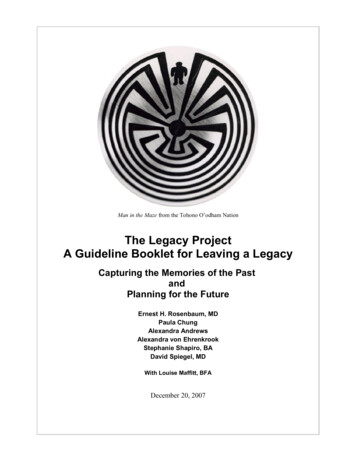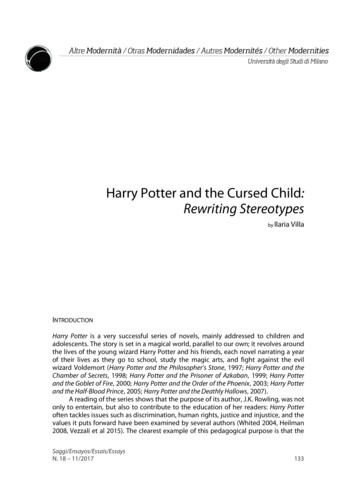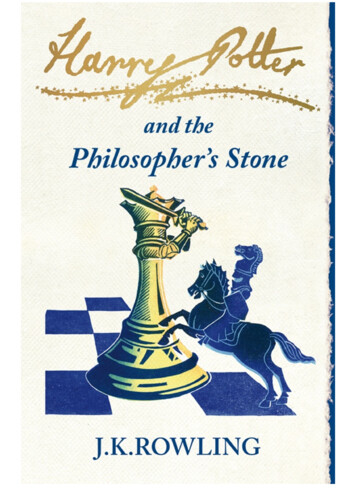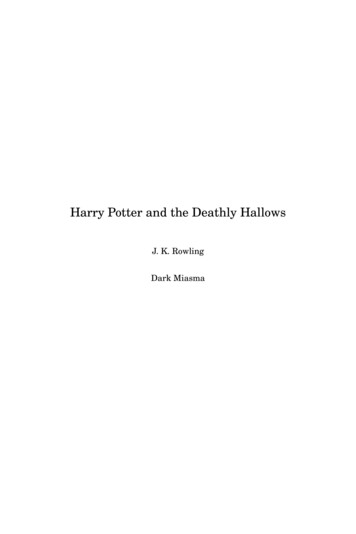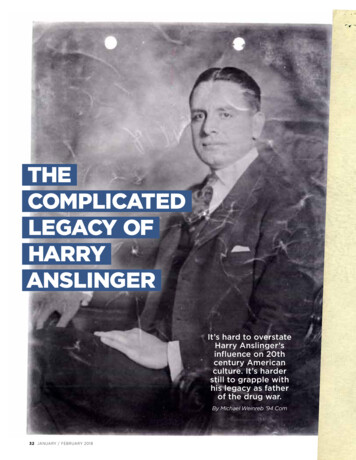
Transcription
THECOMPLICATEDLEGACY OFHARRYANSLINGERIt’s hard to overstateHarry Anslinger’sinfluence on 20thcentury Americanculture. It’s harderstill to grapple withhis legacy as fatherof the drug war.By Michael Weinreb ’94 Com32 JANUARY / FEBRUARY 2018
TK
There are 13.23 cubic feet of material housed withinCollection HCLA 1875 on the first floor of PaternoLibrary, boxes that draw researchers, scholars, writers,and historians from near and far to Penn State, allhis life’s work draws a steady stream of viewers—not tomention would-be-thieves seeking valuable souvenirs—tothe Special Collections archives at University Park. Becauseonce you delve into the history of our nation’s nearly century-long war on drugs, you cannot avoid colliding with Harry Anslinger, the hard-nosed law-and-order man who set itall into motion.“I headed there on a Greyhound bus, and began to readthrough everything I could find by and about Harry Anslinger,” British author Johann Hari writes on the first page of hisbestselling 2015 book Chasing the Scream: The First and LastDays of the War on Drugs. “Only then did I begin to see whohe really was—and what he means for us all.”So what does Harry Anslinger mean for us all? Do a simpleGoogle image search, and you’ll come across dozens of quotesattributed to him, many of them inflammatory, many of themblatantly and horrifyingly racist (and at least a few that An-TKMEDIA MAGNETCountless words by (previous spread) andabout Anslinger can be found at UniversityPark, where his papers are housed in thelibrary’s Special Collections.OPENING SPREAD AND THIS PAGE: PENN STATE ARCHIVESseeking to further their narratives. There are books and transcripts and journals and manuscripts and personal and professional correspondence; there are six audiotapes and 20reels of microfilm; there is a sheath of newspaper clippingsand reports detailing supposed marijuana-induced crimesfrom the 1920s and beyond that is known in the vernacularas the “Gore File.”These are the papers of perhaps the most influential PennState graduate of the 20th century, a man who steered publicpolicy for more than three decades, and whose stances onfederal drug laws had a massive impact on American society.It is very possible that until now, you have never heard thename Harry Anslinger; it’s also very possible you have never heard of the Federal Bureau of Narcotics, the long-defunctagency that Anslinger 1915a Agr headed for 32 years. Andyet in the midst of a massive reformation and re-evaluationof the precepts that Anslinger helped set down, the core of34 JANUARY / FEBRUARY 2018
BETTMANslinger may never have said). Anslinger hasbecome a pariah among marijuana legalizationadvocates, the man many blame for putting uson the path to prohibition, the man responsiblefor the incarceration of so many people ofcolor for minor drug infractions. He is characterized by some of those advocates—and bymany journalists and historians as well—as abureaucratic tyrant, a blatant propagandist, aclosed-minded and single-minded zealot whocarried out a pointed crusade against Mexicansand Asians and (according to an early chapterof Hari’s book) even famed jazz singer BillieHoliday. He has become an internet meme inthose activist circles, the words attributed tohim serving as literal T-shirt slogans for whatmany view as the failed policies of the nation’sdrug war.But get beyond the simple characterizations,and you’ll find that the truth about Harry Anslinger is far more layered than anything thatcan be captured in a single photo or an incendiary quote. The pages in those archives, andthe story of Anslinger’s career battling bothdrugs and organized crime in America, can beread in many different ways.“No great leader is without detractors,” saysCharles Lutz ’67 Lib, a retired Drug Enforcement Agencyspecial agent who has spent years tracing Anslinger’s careerand attempting to preserve his legacy. “They all make mistakes. But Anslinger has been treated very unfairly.”At the very least, his was a complex life, and his is a complex legacy; as more and more states grapple with the potential ramifications of both medical marijuana laws andrecreational marijuana legalization, it is one that scholars willlikely continue to revisit, again and again.“No other single individual had more influence or createda more durable legacy with respect to federal drug controlthan Harry Anslinger,” says John McWilliams, a retired PennState professor who published what many regard as thedefinitive Anslinger biography, The Protectors, in 1990. “Hewas a smart guy. He knew his way around that world. Hewas the consummate bureaucrat.”IT IS A CLASSIC STORY: THE SONof immigrants working his way up the ladder andstraight into the heart of the American zeitgeist. It beginsin Altoona, where Robert Anslinger—a barber in Switzerland who emigrated to America in 1881 in order to avoidAN UNRELENTING VOICEAnslinger had the ear of Washington lawmakersand his fellow law enforcers: In 1934, he spokeat the Attorney General’s “Conference on Crime.”service in the Swiss Army—wound up with his wife aftershunning the urban lifestyle of New York City. Eventually,Robert took a job with the Pennsylvania Railroad. Robert hadnine children and very little money, and his son Harry—bornin 1892—would follow in his father’s footsteps, going to workat the railroad in the ninth grade and taking classes part-timein the mornings.Early on, the use of narcotics—then legal—made an indelible impression on Harry. One moment in particular is vitalto his legend: Hearing the bloodcurdling screams of a woman in a neighboring farmhouse. According to Anslinger’s1961 book The Murderers, the woman’s husband then sentHarry to the drugstore to pick up a package. Harry got it andpaid for it, a 12-year-old boy dispatched for a dose of morphine that, once administered, calmed the woman’s screams.Those screams of a morphine addict would haunt HarryAnslinger. The fact that a kid his age could purchase suchdrugs with no questions—the fact that, in those days, onecould order a syringe kit from Sears & Roebuck through thePE N N STAT ER M AGAZIN E 35
mail—led him to the conviction that drugs that posed sucha danger to the psyche should not be so readily available. Atany moment, Anslinger came to believe, otherwise normalpeople could be turned “emotional, hysterical, degenerate,mentally deficient, and vicious.” The only way forward, inAnslinger’s mind, was a punitive approach, an all-out waragainst drugs.In 1913, Anslinger was granted a furlough by the railroadand left for Penn State, where he enrolled in a two-year associate-degree program. He made extra money by workingas a substitute piano player at the silent movie theater onAllen Street. In 1914, as Anslinger was in the midst of gettinghis degree, the war on drugs officially coalesced with theHarrison Narcotics Tax Act; originally designed as a revenuemeasure, the act was the first to essentially outlaw the use ofseveral drugs, including cocaine, opiates, and heroin.Harry spent the summers away from Penn State workingon a landscaping crew, and this is where, he later said, hefirst encountered his other lifelong nemesis. Every so often,he would hear Italian immigrant workers discussing, inbroken English, something known as the “Black Hand”—anItalian criminal enterprise that targeted recent immigrants.One day, Harry said, he found an Italian coworker badlybeaten and lying in a ditch. After some prodding, the mantold Anslinger he’d been beaten by someone he called “BigMouth Sam,” to whom he’d been forced to pay protectionmoney. Anslinger purportedly threatened to kill Big MouthSam if he came around the railroad again.This story would set the tone for Anslinger’s vendettaagainst the mafia, an organization that U.S. law enforcementofficials—and most notably, FBI director J. Edgar Hoover—refused to officially acknowledge as real until the 1960s.Anslinger understood the power of a good narrative, whether it was exaggerated or not. After finishing at Penn State, hebecame a railroad detective, and after saving the railroad 50,000 in a negligence suit, he was promoted to captain ofthe railroad police. He was on his way.ANSLINGER SERVED WITH THEState Department overseas at the tail end ofWorld War I, gathering intelligence on Germany’s Kaiser Wilhelm and others, and eventually moving on to the Bahamas to observe rum-runners duringProhibition. By the late 1920s, Prohibition was failing, andthe Prohibition Bureau was rife with corruption and neededto be reorganized. A Pennsylvania congressman introduceda bill to create a new bureau to separate drug enforcementfrom liquor violations. And so, in 1930, eight weeks afterbeing named acting commissioner of the newly formed Fed-36 JANUARY / FEBRUARY 2018eral Bureau of Narcotics (FBN)—this after Anslinger leveragedthe recommendations of old friends and colleagues to President Herbert Hoover—his position was made permanent.Anslinger first became a lightning rod for controversywhen he began zeroing in on marijuana. How much of thiswas his own doing, and how much of it was a result of forces already at work when Harry took on his job, depends onwho you talk to. Hari, in Chasing the Scream—titled afterAnslinger’s formative experience in that Altoona farmhouse—frames Anslinger’s anti-marijuana crusade as driven byracism and anti-immigrant sentiment, as a cynical attemptto consolidate the power of the FBN at a time when it wasvulnerable. But not all scholars agree that it was so blatant.“I do think Anslinger’s role has been overplayed,” saysAdam Rathge, a Ph.D. student in the history department atBoston College who is completing a dissertation on the history of marijuana prohibition in the United States. “I certainly don’t want to come across as an Anslinger apologist, as hewas not the most politically correct person, and I don’t thinkhe’s off the hook by any stretch. But the level of angst andanger is easily channeled to him because he was head of theFBN for 30-plus years.”Lutz, the former DEA agent, argues that Anslinger neverwanted marijuana to be a federal crime—Anslinger fearedthat if it were, it would distract his agents from heroin cases.But since the marijuana was originating from Mexico, Lutzmaintains, Congress demanded that Anslinger stop it.Here is what we can say for sure: Certain forces were inplace as Anslinger came into power, and those forces converged around marijuana prohibition. Some of those forceswere indubitably driven by racial fears, in particular a fearof Mexicans; marijuana had made its way across the borderand into New Orleans, and then up the Mississippi Riverand into the North and Midwest. A drug Anslinger and manyothers had previously viewed as a largely harmless diversionfrom more serious narcotics like morphine and opiates beganto stoke public fears. It didn’t matter that a majority of Mexicans “saw marijuana as the most dangerous drug available,”Rathge says, and that Mexico had made it illegal years beforeAmerica did. As Mexicans flooded into the country in theearly part of the 20th century, those immigrants becametargets.This led to the compiling of Anslinger’s “Gore File,” hiscollection of clippings like the one from The New York Timesin 1927, headlined “MEXICAN FAMILY GO INSANE,” abouta widow and her four starving children who ate a marijuanaplant, thereby supposedly dooming her children to deathand ensuring her lifelong dementia. Reports like these camein from all over: A newspaper editor in Colorado cited “degenerate Spanish-speaking residents” and pleaded for assis-
PENN STATE ARCHIVESFIGHTING “MURDER WEED”Historians debate his intent, but there’sno question that marijuana was widelyvilified by the government and the mediaduring Anslinger’s tenure.tance from Anslinger; another story cited “two Negroes” whoreportedly held a 14-year-old girl for two days by keepingher under the influence of marijuana. Another report told of“colored students” at the University of Minnesota “partyingwith female students (white) smoking and getting their sympathy with stories of racial persecution. Result: Pregnancy.”The case of Victor Licata, in which a young man in Floridamurdered his family with an axe while under the influenceof marijuana, became perhaps Anslinger’s most cited example of the drug’s alleged dangers (though psychiatrists foundthat Licata suffered from “acute and chronic insanity,” anddidn’t even mention his marijuana use in their files).Was Anslinger an overt racist, as evidenced by his apparent targeting of renowned African-American jazz musicianslike Billie Holiday and Charlie Parker over white drug userslike the actress Judy Garland? Was his reference to a bureauinformer as a “ginger-colored n----r”—a statement that ledto calls for his resignation—a sign of his true self, or was itwritten by a staffer and signed off on by Anslinger? Was hedriven by the media-fueled notion that Mexicans and African-Americans were evangelizing and providing marijuanato young white users? Or was he simply reacting to thepublic pressure that ballooned out of these reports? Eitherway, whether buoyed by true belief or cynicism or somecombination of both, this is where Anslinger latched on tothe notion of marijuana as both a menace and a political boonfor his bureau.“His focus was on the fact that America’s youth was beingthreatened,” Rathge says. “Did he singlehandedly manufacture the notion of making marijuana illegal in the UnitedStates? Absolutely not.”“But for the first time,” Hari wrote, Anslinger gave thesestories “the backing of a government department that wouldbroadcast them to the nation at full volume, with an officialgovernment stamp saying they were true.”Combing through the limited medical studies of the time—many of which, Rathge says, were “fundamentally flawedand racist”—Anslinger clung to those that confirmed hisnewfound views and ignored those that didn’t. He spoke towomen’s clubs and temperance groups and church organizations; Hari writes that Anslinger silenced doctors whoargued for a more compassionate approach toward all kindsof drug addicts. In 1937, as often-apocryphal tales of marijuana’s links to violence grew more frequent—and the yearafter the release of the propaganda film Reefer Madness, a filmmany associate with Anslinger despite no evidence he wasinvolved—Anslinger co-authored a magazine article titled“Marijuana: Assassin of Youth.” That same year, he testifiedbefore the Senate Ways and Means Committee about theinherent evils of this plant. He told Congressmen that it“incites the user to crime”; he told them of multiple reportsof marijuana provoking violence.“He created the image of a ‘typical’ marijuana user,” McWilliams says, and among those users were Mexicans crossingPE N N STAT ER M AGAZ IN E 37
the border, black jazz musicians, and other marginalizedminorities. “Legislators had no clue. It was easy for HarryAnslinger to create this myth.”In April of 1937, Congress passed the Marijuana Tax Act,setting the stage for decades of prohibition and increasinglypunitive drug laws. But even this is only one element ofAnslinger’s considerable legacy, because as he was waginga crusade against drugs, he was also fighting what he considered an intertwined threat: The creeping specter of the“Black Hand” that he had encountered back in Altoona.EVEN AS J. EDGAR HOOVER,Anslinger’s powerful counterpart at the FBI, refused to acknowledge the existence of a mafia,Anslinger was targeting mafia-driven drug distribution rings in places like St. Louis and Kansas City. He islargely credited as the first federal official to have “discovered”the mafia, breaking up syndicates in Harlem and Chicago.“He was right about organized crime,” McWilliams says.“He started making arrests as early as the 1930s and 1940s.”After the exiled gangster Lucky Luciano wound up inCuba, Anslinger—suspecting Luciano was moving drugsand seeking to control the island’s gambling business, andfearing he would get back into the heroin business in theUnited States—announced the U.S. would stop shippinglegitimate drugs to Cuba until Luciano was expelled. He wastaken into custody the next day, and sent back to Italy. “Whenthe Russians land on the moon,” Luciano once said, “the firstman they meet will be Anslinger, searching for narcotics.”Anslinger reached out to other countries, as well, workingwith INTERPOL to establish cooperation across borders. Asthe U.S. representative to the United Nations Narcotics Control Board, he created a convention that consolidated drugtreaties; he established Federal Bureau of Narcotics offices insuch far-flung cities as Beirut, Istanbul, and Bangkok, andsent agents overseas to aid drug investigations. “He wastruly the founder of international drug enforcement,” saysLutz, the retired DEA agent.Anslinger’s approach could be harsh. When Thailand refused to ban opium smoking, Anslinger threatened to cut offaid until the country complied with the FBN’s operations.“Don’t confuse me with facts,” he would say when representatives of other countries tried to change his mind, accordingto Hari’s book. But it worked—in the end, nearly everyother country succumbed to Anslinger’s big-stick policies.He was, for better or worse, ferociously driven, to the pointthat many members of his extended family rarely saw him,to the point that the job took its toll on his health and appearance. Perhaps due to stress, he lost nearly all of his lush headof black hair soon after taking the commissioner’s job. At one38 JANUARY / FEBRUARY 2018point in 1935, according to author Jill Jonnes’ 1996 book HepCats, Narcs and Pipe Dreams, he had a mental breakdown andbriefly had to step away from work altogether.“He was always away on official business,” says his greatniece, Nanette Anslinger ’64 A&A, who recalls her unclevisiting her once while she was a student at Penn State andgiving her 50 to buy a bicycle, and choking down oystersRockefeller with him during a visit to Washington. “But Iwas proud of my Uncle Harry. [His work] kept me straightduring a time when many were experimenting with drugs.He may have been a little over the top in his approach, but Inever wanted to disappoint him.”This was Anslinger’s way: He testified that CommunistChina was seeking to weaken the morale of the free worldby flooding it with heroin. In the 1950s he championed theBoggs Act and the Narcotics Control Act, which ratchetedup penalties for drug offenses. As early as the 1940s, Anslinger had joined other government agencies in highly classifieddrug experiments designed to “induce people to tell the truthagainst their will,” McWilliams wrote. (Ironically, one of theprimary drugs they experimented with was marijuana.)His agents gained more reach and more power: One inparticular, a renegade named George White, became involvedin the CIA’s Cold War mind-control experiments that provided LSD to unwitting subjects at safe houses in New YorkCity and San Francisco. And while the extent of Anslinger’sparticipation is unknown, a CIA pharmacologist testifiedafter Anslinger’s death that “Mr. Anslinger was knowledgeable of the safe houses that we have set up and why,” andthat he encouraged his agents to take part in the experiments.Anslinger—who was named a Penn State DistinguishedAlumnus in 1959—was nearing 70 by the time the 1960sdawned. He presumed he’d be replaced once John Kennedycame into office. Instead, he was reappointed to his position,and cultivated a strong relationship with Kennedy’s brotherand attorney general, Robert Kennedy. But his wife Marthawas growing increasingly ill, confined to her room; she diedin 1961. Facing increasing criticism of his methods frommedical and legal professionals who believed in a morecompassionate approach to drug addiction, Anslinger retiredin 1962. He returned to the home he owned in Hollidaysburg,Pa., drinking coffee at the local luncheonette, going on occasional hunting trips, playing poker with friends—and continuing his personal crusade against marijuana use.By the late 1960s, marijuana became a lightning rod onceagain, viewed as the preferred drug of the counterculture,venerated by the hippies that Anslinger saw as “such a greatthreat to American traditional values,” McWilliams says.Anslinger, in a 1968 interview, called the hippies “the onlypersons who frighten me,” and blamed “permissive parents,college administrators, pusillanimous judiciary officials,
PENN STATE ARCHIVESPE N N STAT ER M AGAZ IN E 39
do-gooder bleeding hearts, and new-breed sociologists withtheir fluid notions of morality” for the proliferation of marijuana. This, he believed, was a fundamental assault on thefoundations of Western civilization. Later, in a 1970 roundtable debate with Playboy, Anslinger railed against nationswho had succumbed to “moral laxity and hedonism.”Soon after, his eyesight failed and Anslinger went blind,and he was already dealing with angina and a prostate condition that limited his mobility. Nanette Anslinger recallsvisiting him and holding his hands and watching her greatuncle run his fingers over her various rings while she described them. He died at age 83 in 1975, two decades beforethe tide of drug policy began to decisively turn against him.“I’ve lived long enough,” he told Nanette on his deathbed.CHARLES LUTZ SPENT THREEdecades in federal law enforcement, much of itwith the Drug Enforcement Agency, the heir toAnslinger’s Federal Bureau of Narcotics. Whenhe retired, he needed a project to keep his investigative mindoccupied. Combing through old books commemoratingvarious anniversaries of the DEA, he found little mention ofHarry Anslinger. He told the DEA it needed to include An-slinger as part of its history. How could it be that a man whospent 32 years as the head of a major government agencycould have disappeared entirely from view?Lutz read every book he could find by or about Anslinger.He began to believe that Anslinger’s negative legacy waslargely being shaped by marijuana activists “to further theirown goals.” Digging deeper, he learned that Anslinger hadhired 35 African-American agents at the FBN, and that in1930 he had hired a Chinese agent, believed to be the firstChinese-American hired by any law-enforcement agency inthe U.S. He spoke to one of Anslinger’s hires, an African-American agent named Bill Davis, who told him thatAnslinger treated him fairly and respectfully. He spoke toother minority agents and insists that none of them condemned Anslinger for his racial views.“Anslinger,” Lutz insists, “was anything but a racist.”There is a difference, of course, between hiring minoritiesand furthering policies that might disproportionately impactminority populations. Those things are not mutually exclusive,and Lutz admits that he doesn’t know whether Anslingerhired those minorities for “pragmatic reasons, to get the jobdone” by working in minority communities, or whether he“had some higher motive in mind.” But the way Lutz seesit, Anslinger has been “unjustly maligned by the pro-mari-PENN STATE ARCHIVESDANGEROUS BOUNTYPhoto ops with seized drugs werepowerful PR for Anslinger and theFederal Bureau of Narcotics.40 JANUARY / FEBRUARY 2018
BETTMANjuana legalization crowd.”In 2014, Lutz helped to arrange for McWilliams to lectureat the DEA about Anslinger’s legacy; 18 members of Anslinger’s family attended, as did an aging Bill Davis, the African-American agent who served under Anslinger. NanetteAnslinger’s father donated several items of memorabilia tothe DEA Museum in Virginia, and the DEA named a conference room after him. Lutz discovered that a plaque commemorating Anslinger that had been hung at the Blair CountyCourthouse in Hollidaysburg during a “Harry AnslingerDay” had gone missing, and he convinced the county commissioner to agree to replace it.So what does Harry Anslinger mean for us all? It dependson whether, like Charles Lutz, you comb through CollectionHCLA 1875 and believe Anslinger’s notions of prohibitionand punishment are still the most valid tools we possess inthe battle against drugs; or whether you think Anslingerpreyed upon public fears to further his aims, and championedbarbaric policies that marginalized minorities and criminalized addicts. His policies, McWilliams writes, were “oppressive and overly simplistic,” and he could be “tyrannical andinflexible,” but he also gathered valuable intelligence throughhis international operations, and he fought organized crime,and for his three decades in Washington, he was virtuallyomnipresent.AN ENDURING FIGUREFirst appointed by Herbert Hoover,Anslinger remained in charge of the FBNthrough the Kennedy administration.As polls continue to show that an increasing number ofAmericans favor the relaxation of marijuana laws, Anslinger’sview of the world has begun to feel more and more like ananachronism, a throwback to an era when marijuana wasfirst transformed from a nebulous social ill into somethingfar more sinister (and political). “What would Anslingerthink, I wonder, if he knew medical marijuana was nowavailable in 18 [now 29] states?” McWilliams asked duringhis 2014 DEA lecture. “What would he think if he knewmarijuana was available for recreational purposes in two[now eight] states? I suspect he would call it ‘reefer madness.’”Despite his intensity, despite his often dictatorial means,Nanette Anslinger recalls that her great-uncle still had asense of humor. When the Village Voice published a doctoredphoto of Anslinger wearing a wreath of marijuana leaves, ithung on the wall at the drugstore in Hollidaysburg whereAnslinger used to while away his final years. He loved it.Michael Weinreb is a San Francisco-based writer and theauthor most recently of Season of Saturdays: A History ofCollege Football in 14 Games.PE N N STAT ER M AGAZIN E 41
bestselling 2015 book Chasing the Scream: The First and Last . Hearing the bloodcurdling screams of a wom-an in a neighboring farmhouse. According to Anslinger’s 1961 book The Murderers, the woman’s husband then sent Ha



